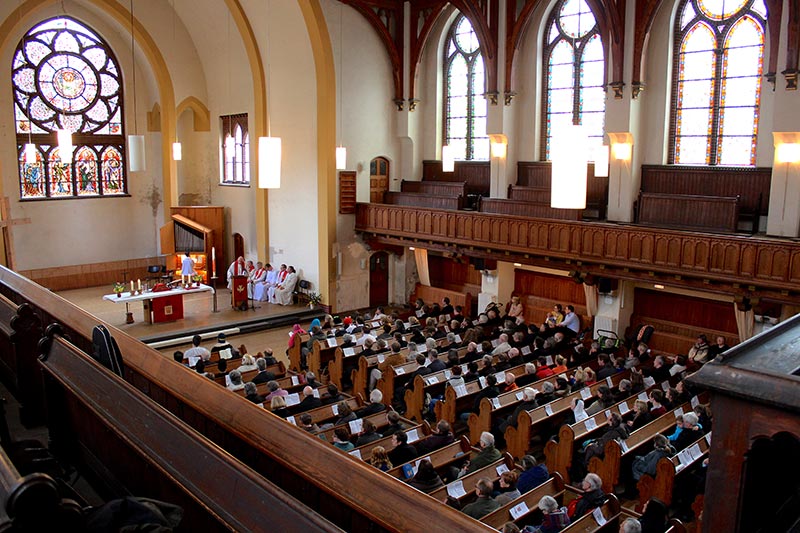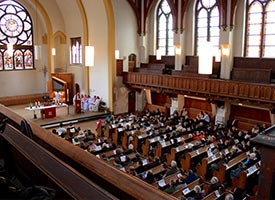
By Rick Steenbock
LEIPZIG, Germany — On Easter Monday, while Christians were still basking in the victorious glow of Christ’s resurrection and their salvation, representatives of The Lutheran Church—Missouri Synod, Germany’s Independent Evangelical Lutheran Church (SELK) and the Free Evangelical Lutheran Synod in South Africa (FELSISA) met here to also celebrate the “resurrection” of a congregation and a historic church building.
The day also was blessed with the ordination of Thomas Beneke, who served his two-year vicarage in Leipzig under the guidance of SELK missionary Rev. Hugo Gevers.
Holy Trinity history
A part of Leipzig since 1907, Sankt Trinitatisgemeinde (Holy Trinity Lutheran Church) can trace its roots back to 1894. Despite two world wars, the lack of a permanent worship space and decades under communist rule, the congregation survived and at times even thrived.
But by 2005, its membership had dwindled from a high point of more than 400 members to about 75. The SELK and the Rev. Markus Fischer — who became pastor of the congregation in 2006 — determined that Holy Trinity’s location well outside the city center and almost hidden near a forest was the main problem.
At the same time, they began to see a trend of Persian refugees settling in the vicinity of Leipzig.
Reaching out
Recognizing an opportunity to reach this growing immigrant group, the SELK and its mission arm, the Lutherische Kirchenmission (LKM), called South African pastor Hugo Gevers in 2007 to serve as a missionary to the Persian refugee population in eastern Germany. Both entities also asked the LCMS to help support Gevers’ ministry financially. Together, Pastors Gevers and Fischer ministered to the Persian refugees and connected them to SELK congregations in Berlin, Leipzig and other areas.
In 2011, Gevers, Fischer and LKM Director Rev. Roger Zieger approached the LCMS Office of International Mission with a plan to move Holy Trinity’s congregation from the edge of the city to the largely vacant Lukaskirche (St. Luke’s Church) in the Volksmarsdorf district of Leipzig. This urban neighborhood is home to many underprivileged and ethnic immigrants.
Additionally, LKM planned an outreach center across from the church called die Brücke (the Bridge), which opened in August 2012. Gevers and Vicar Beneke ministered to the refugees by day; in the afternoons and evenings, they reached out to the children and others living in Volksmardorf with “acts of mercy” such as child care, food, clothing and help with obtaining visas — trying to fill in the “gaps” between what the people had and what they needed. Gevers also leads Bible study at the Bridge.
Again, with support from the LCMS, renovations began on the St. Luke’s building.
Rebirth at St. Luke’s
St. Luke’s was built between 1891-93 in the working-class district of Volksmarsdorf. Shortly after the fall of the Iron Curtain in 1989-90, the parish became inactive and the building stood for nearly 20 years with almost no activity inside or out. It fell into disrepair and still needs much renovation.
Through the partnership of the SELK and the LCMS, renovations began in 2012. Once renovations are completed, the sanctuary will have seating for 1,000 people. Because of its acoustics, the church building also has been touted as an ideal location for concerts.
The LCMS also agreed to send a missionary to assist with music at the church. The Rev. Dr. Christopher Ahlman began his service in spring 2013 to develop and implement a music ministry for the Holy Trinity congregation, now worshiping at St. Luke’s. His wife, Deaconess Elizabeth Ahlman, is Eurasia communications specialist for the LCMS.
“Engaging the city of Leipzig — not just Volksmarsdorf — in very intentional, goal-oriented ways where the Gospel of Jesus Christ will ultimately be advanced, and by the power of the Spirit, more people will be brought into the church and the church strengthened,” Christopher Ahlman said.
Holy Trinity has begun a new chapter in Leipzig. Its membership has nearly doubled since 2005, and a third of its members are Persian. Every Sunday, the Scriptures are read in both German and Farsi, and after the service, Gevers repeats the sermon with a translator for the Farsi-speaking people.
Congregation members are excited about the future and the opportunity to share Christ’s love with their neighbors through the die Brücke outreach ministry and in other ways.
New beginnings
April 6, 2015, marks a new beginning for a congregation, a church building and a pastor. On that Easter Monday, St. Luke’s was almost overflowing with representatives from SELK congregations, the LCMS Office of International Mission, Holy Trinity and — perhaps most important — residents of Volksmarsdorf.
Many of the children who have made the Bridge their second home — taking part in regular “soup suppers” and other activities — also were in attendance, and one young man served as the crucifer for this service, which Fischer called “a festival of the resurrection of Christ and also this church building.”
Vicar Thomas Beneke — now Rev. Thomas Beneke — will soon be back in his native South Africa where he has been called to serve.
Thirteen pastors — including two from the LCMS — were on hand to take part in the celebration, where God’s Word was shared in German and in Farsi. Bishop Hans-Jörg Voigt of the SELK delivered the sermon. And a brass band — along with an organ played by Ahlman — provided the musical backdrop.
“We thank God for our [SELK] congregations and our brothers and sisters from the LCMS for all their support of this project,” said Voigt.
Beneke put it this way: “I think that in life there are times of joy and hardship, and this was definitely a great time of joy!”
Rick Steenbock is communications and projects coordinator for Eurasia with the LCMS Office of International Mission and is based in Frankfurt, Germany.
Posted April 15, 2015
